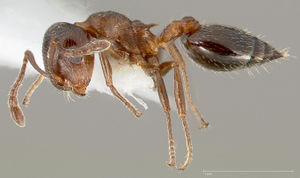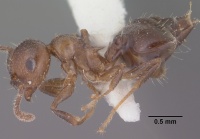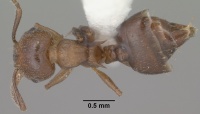Crematogaster emeryana
| Crematogaster emeryana | |
|---|---|

| |
| Scientific classification | |
| Kingdom: | Animalia |
| Phylum: | Arthropoda |
| Class: | Insecta |
| Order: | Hymenoptera |
| Family: | Formicidae |
| Subfamily: | Myrmicinae |
| Tribe: | Crematogastrini |
| Genus: | Crematogaster |
| Species group: | scutellaris |
| Species: | C. emeryana |
| Binomial name | |
| Crematogaster emeryana Creighton, 1950 | |
This ant nests under stones or logs (or in logs), with brood present in April and July, and sexuals present in nests in July and August. This species appears to be polygynous, with up to 9 dealate females found in a single nest. One colony was nesting together with Lasius sp. and Tapinoma sessile. (Mackay and Mackay 2002)
Identification
A member of the Crematogaster scutellaris group.
This species can be recognized due to the presence of several erect hairs on the pronotal shoulder, in addition to at least one pair on the rear of the mesonotum. (Mackay and Mackay 2002)
Morgan & Mackay (2017) - The key characteristics of the C. emeryana worker are the combination of rugose sculpturing and short bristle-like hairs on the pronotum and the reduced propodeal spines. Crematogaster emeryana is nearly identical to Crematogaster cerasi, and can be separated as the dorsal surface of the propodeal spine is straight, not sinuate as in C. cerasi.
Crematogaster marioni
It seems likely C. marioni is a valid species rather than a synonym. It can be separated as follows (Buren, 1968): There is no other species in California or Baja California with which marioni is likely to be confused. It does seem close to Crematogaster isolata, but is perfectly distinct, especially in pilosity, and there would seem no chance for confusion.
Keys including this Species
Distribution
Arizona and east to Texas, north to Colorado and Utah, south into northern Mexico.
Morgan & Mackay (2017) - Crematogaster emeryana has been collected in the southwestern United States and northwestern México, including Baja California (Johnson and Ward, 2002, as C. marioni).
Latitudinal Distribution Pattern
Latitudinal Range: 41.71° to 19.31741667°.
| North Temperate |
North Subtropical |
Tropical | South Subtropical |
South Temperate |
- Source: AntMaps
Distribution based on Regional Taxon Lists
Nearctic Region: United States (type locality).
Neotropical Region: Mexico.
Distribution based on AntMaps
Distribution based on AntWeb specimens
Check data from AntWeb
Countries Occupied
| Number of countries occupied by this species based on AntWiki Regional Taxon Lists. In general, fewer countries occupied indicates a narrower range, while more countries indicates a more widespread species. |

|
Habitat
Mountain forests, oak forests, riparian canyon forests, grasslands, urban habitats.
Biology
Nevada, Wheeler and Wheeler (1986) - Two colonies were nesting under stones in a deep narrow canyon filled with shrubs and trees.
Morgan & Mackay (2017) - Mackay and Mackay (unpublished) have collected extensive data on Crematogaster emeryana. Most nests are found under stones, but they are also found in dead branches of oaks (Quercus emoryi), in/under the bark of logs and in an oak gall (5 cm diameter, about ¼ of gall occupied).
Brood were found in nests in March, April, June, July, August and October, sexuals in April and July. Several nests of C. emeryana from the South West Research Station in Arizona had 2 or more dealate queens under the same stone with brood and / or pupae (Morgan, unpublished), as well as in other areas (Mackay and Mackay, unpublished). Workers tend to be relatively sluggish and escape when a nest is disturbed.
It forages during a soil surface temperature range of 14.4-62.2°C (Bernstein, 1979b), and can be found loose on the ground and in the litter of old forest and pine-oak litter (Mackay and Mackay, unpublished).
It is found in a variety of habitats including thorn scrub, mesquite thorn scrub, grassland with juniper trees, pinyon juniper forests, a grassy clearing with oak surrounded by pinyon pine/juniper forest, Apache and Chihuahuan pine/alligator bark juniper/cypress, and riparian forest (oak, cottonwood) (Mackay and Mackay, unpublished). It was reported from a pinyon pine community in northern Arizona (Trotter et al., 2008).
Several guests were found in nests, including the cricket Myrmecophila sp., pselphids and other beetles as well as pseudoscorpions. It is enslaved by the ant Dorymyrmex insana in the Mojave Desert (Bernstein, 1978).
It is found in several soil types including sandy loam, rocky, light brown sandy loam, light brown rocky sand, brown rocky loam, rocky sand and grey gravel.
Bernstein (1979a) discussed the evolution of niche breadth in C. emeryana.
Life History Traits
- Queen number: monogynous (Frumhoff & Ward, 1992)
Castes
Images from AntWeb
   
| |
| Worker. Specimen code casent0005670. Photographer April Nobile, uploaded by California Academy of Sciences. | Owned by UCDC, Davis, CA, USA. |
Nomenclature
The following information is derived from Barry Bolton's Online Catalogue of the Ants of the World.
- emeryana. Crematogaster (Acrocoelia) lineolata subsp. emeryana Creighton, 1950a: 213 (w.) U.S.A. (Colorado).
- Type-material: syntype workers, syntype queens (numbers not stated).
- Type-locality: U.S.A.: Colorado (no collector’s name).
- [Note: Creighton based this taxon upon a “Varietät aus Colorado” which was described by Emery, 1895c: 282, but not named.]
- Type-depository: MSNG.
- Morgan & Mackay, 2017: 172 (q.m.).
- Combination in C. (Crematogaster): Buren, 1968b: 94 (in key).
- Subspecies of lineolata: Smith, M.R. 1958c: 126; Beck, et al. 1967: 68; Smith, M.R. 1967: 356.
- Status as species: Buren, 1968b: 94 (in key); Hunt & Snelling, 1975: 21; Smith, D.R. 1979: 1378; Allred, 1982: 460; Wheeler, G.C. & Wheeler, J. 1986g: 48; Bolton, 1995b: 152; Mackay & Mackay, 2002: 90; Morgan & Mackay, 2017: 171 (redescription).
- Distribution: Mexico, U.S.A.
Type Material
Crematogaster marioni
Holotype worker and numerous paratypes from several nests in either dead manzanita stems or branches or on live oak at Morena Lake, San Diego Co., Calif., W. F. Buren. The species is also represented by numerous specimens collected by Dr. Wm. S. Creighton, which I have also marked as paratypes, from 13 mi. E. of Tecate, Baja California, Mex.; Dripping Springs Camp Ground, Aguatibia Mts., Calif. (3 colonies); Cameron Corners, San Diego Co., Calif.; and Canyon City, San Diego Co., Calif.; all these records from live oaks. I have also marked as paratypes a few specimens from Robertson Creek, Monterey, Calif., and have seen specimens from Santa Barbara, Pasadena, and San Ysidro, Calif. The holotype and a few paratype specimens are to be sent to the National Museum. Other paratypes will be sent to the Museum of Comparative Zoology, American Museum of Natural History, California Academy of Natural Sciences, and the personal collection of Dr. Creighton. I will retain paratypes from each series.
Taxonomic Notes
Morgan & Mackay (2017) - The types of Crematogaster marioni cannot be distinguished from specimens of C. emeryana. Buren describes the sculpturing on the face as weak, scapes as scarcely surpassing hind corners and the propodeal spines of moderate length, all typical character states of C. emeryana. We are therefore synonymizing Crematogaster marioni Buren as a junior synonym of Crematogaster emeryana Creighton. The spines are neither reduced as in Crematogaster isolata or long as in Crematogaster punctulata, other species found in overlapping geographical areas.
Description
References
- Buren, W. F. 1968b. A review of the species of Crematogaster, sensu stricto, in North America (Hymenoptera, Formicidae). Part II. Descriptions of new species. J. Ga. Entomol. Soc. 3: 91-121 (page 94, Combination in C. (Crematogaster), and raised to species; (in key))
- Creighton, W. S. 1950a. The ants of North America. Bulletin of the Museum of Comparative Zoology 104: 1-585 (page 213, worker described)
- Jansen, G., Savolainen, R. 2010. Molecular phylogeny of the ant tribe Myrmicini (Hymenoptera: Formicidae). Zoological Journal of the Linnean Society 160(3), 482–495 (doi:10.1111/j.1096-3642.2009.00604.x).
- Mackay, W.P. & Mackay, E.E. 2002. The Ants of New Mexico: 400 pp. Edwin Mellen Press, Lewiston, N.Y.
- Morgan, C.E., Mackay, W.P. 2017. The North American Acrobat Ants of the hyperdiverse genus Crematogaster (Hymneoptera: Formicidae). Lambert Academic Publishing (PDF version, 532 pp.)
- Ward, P.S., Blaimer, B.B. 2022. Taxonomy in the phylogenomic era: species boundaries and phylogenetic relationships among North American ants of the Crematogaster scutellaris group (Formicidae: Hymenoptera), Zoological Journal of the Linnean Society 194(3): 893–937 (doi:10.1093/zoolinnean/zlab047).
- Wheeler, G. C. and J. Wheeler. 1986. The ants of Nevada. Natural History Museum of Los Angeles County, Los Angeles.
References based on Global Ant Biodiversity Informatics
- Allred D. M. 1982. Ants of Utah. The Great Basin Naturalist 42: 415-511.
- Allred, D.M. 1982. The ants of Utah. Great Basin Naturalist 42:415-511.
- Backlin, Adam R., Sara L. Compton, Zsolt B. Kahancza and Robert N. Fisher. 2005. Baseline Biodiversity Survey for Santa Catalina Island. Catalina Island Conservancy. 1-45.
- Beck D. E., D. M. Allred, W. J. Despain. 1967. Predaceous-scavenger ants in Utah. Great Basin Naturalist 27: 67-78
- Buren W.F. 1968. A Review of the species of Crematogaster, Sensu Stricto, in North America (Hymenoptera, Formicidae) Part 2. Descriptions of New Species. J. Georgia Entomol. Soc. 3: 91-121
- Cover S. P., and R. A. Johnson. 20011. Checklist of Arizona Ants. Downloaded on January 7th at http://www.asu.edu/clas/sirgtools/AZants-2011%20updatev2.pdf
- Dattilo W. et al. 2019. MEXICO ANTS: incidence and abundance along the Nearctic-Neotropical interface. Ecology https://doi.org/10.1002/ecy.2944
- Des Lauriers J., and D. Ikeda. 2017. The ants (Hymenoptera: Formicidae) of the San Gabriel Mountains of Southern California, USA with an annotated list. In: Reynolds R. E. (Ed.) Desert Studies Symposium. California State University Desert Studies Consortium, 342 pp. Pages 264-277.
- Gregg, R.T. 1963. The Ants of Colorado.
- Johnson R. Personnal Database. Accessed on February 5th 2014 at http://www.asu.edu/clas/sirgtools/resources.htm
- Johnson, R.A. and P.S. Ward. 2002. Biogeography and endemism of ants (Hymenoptera: Formicidae) in Baja California, Mexico: a first overview. Journal of Biogeography 29:10091026/
- Longino, J.T. 2010. Personal Communication. Longino Collection Database
- Mackay W. P., and E. E. Mackay. 2002. The ants of New Mexico (Hymenoptera: Formicidae). Lewiston, New York: Edwin Mellen Press, 400 pp.
- Moody J. V., and O. F. Francke. 1982. The Ants (Hymenoptera, Formicidae) of Western Texas Part 1: Subfamily Myrmicinae. Graduate Studies Texas Tech University 27: 80 pp.
- Morgan C., and W. P. Mackay. 2017. The North America acrobat ants of the hyperdiverse genus Crematogaster. Mauritius: LAP LAMBERT Academic Publishing, 540 pp.
- Morgan, C.E. 2009. Revision of the ant genus Crematogaster (Hymenoptera: Formicidae) in North America. Ph.D. Dissertation, University of Texas at El Paso, 268 pp.
- O'Keefe S. T., J. L. Cook, T. Dudek, D. F. Wunneburger, M. D. Guzman, R. N. Coulson, and S. B. Vinson. 2000. The Distribution of Texas Ants. The Southwestern Entomologist 22: 1-92.
- Wetterer, J. K.; Ward, P. S.; Wetterer, A. L.; Longino, J. T.; Trager, J. C.; Miller, S. E. 2000. Ants (Hymenoptera: Formicidae) of Santa Cruz Island, California. Bulletin of the Southern California Academy of Sciences 99:25-31.
- Wetterer, J.K., P.S. Ward, A.L. Wetterer, J.T. Longino, J.C. Trager and S.E. Miller. 2000. Ants (Hymenoptera:Formicidae) of Santa Cruz Island, California. Bulletin of the Southern California Academy of Science 99(1):25-31.
- Wheeler G. C., and J. Wheeler. 1986. The ants of Nevada. Los Angeles: Natural History Museum of Los Angeles County, vii + 138 pp.
- Wheeler, G.C. and J. Wheeler. 1985. A checklist of Texas ants. Prairie Naturalist 17:49-64.

